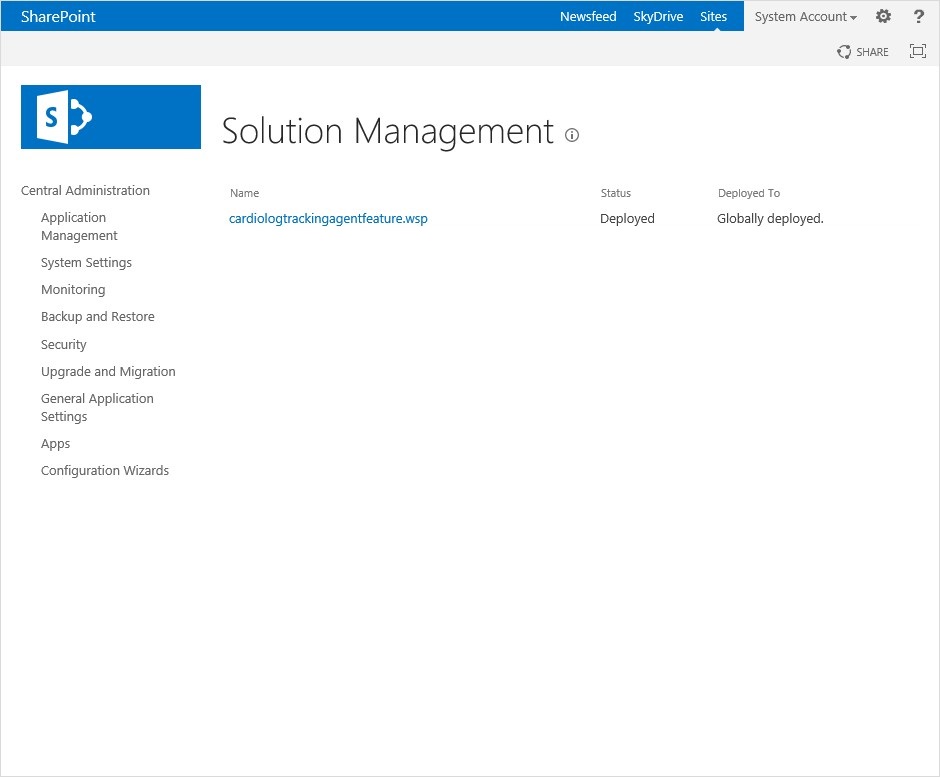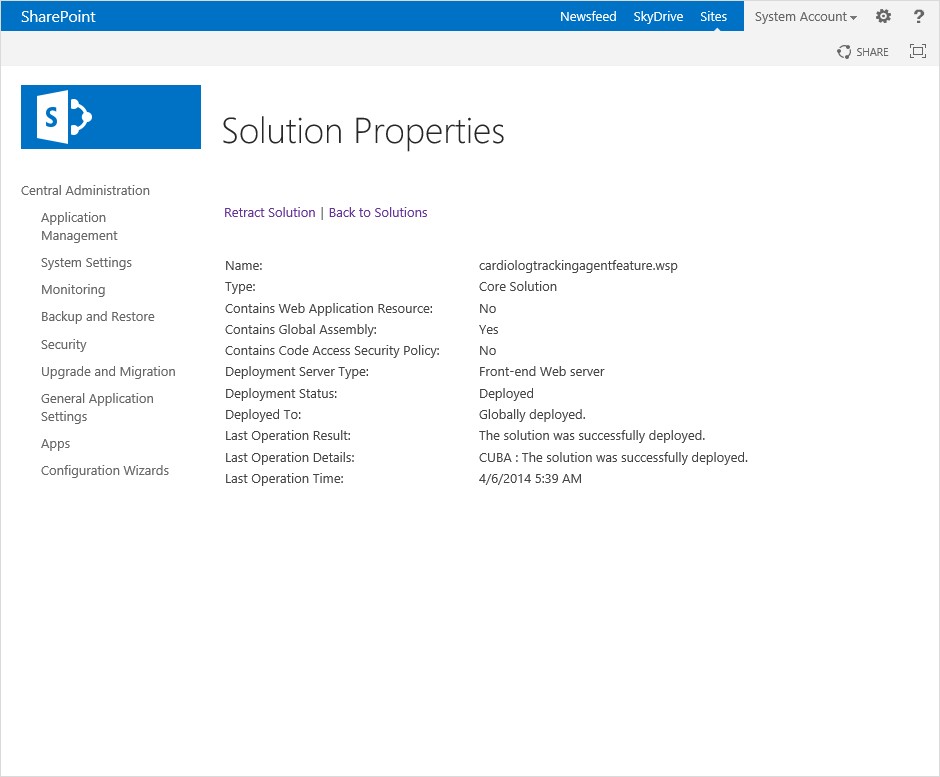Page History
...
- Running the Configuration Wizard
- Deploy 'CardioLog Analytics' SharePoint Feature
- Automatically add Add the JavaScript tracking codeTracking Code
- Manually add Add a JavaScript tracking codeTracking Code
- Tracking Document Usage from within Office
- Configuring Multiple Web Applications
- Configuring Multiple Farms
- Configuring Reporting Data Cache
...
- Launch CardioLog, or select Configuration Wizard from the System Configuration window, under Administration.
- In the Welcome dialog, select your desired language and date format from the drop-down menu, and the version of SharePoint that you are currently using, then click Next.
Configuration Wizard
This step can be performed in one of the following ways:
(1) Automatically add the JavaScript tracking code to all SharePoint pages served by the WFE by deploying the CardioLog tracking code through a SharePoint solution.
(2) Automatically add the JavaScript tracking code to all SharePoint pages served by the WFE by adding the tracking code to init.js in SharePoint 2010/13, and core.js in SharePoint 2007 (recommended for test environments only).
(3) Manually add the JavaScript tracking code.
Note: Please select one option only to configure the Tracking Agent.
(1) Deploy 'CardioLog Analytics' SharePoint FeatureAnchor deploy cardiolog analytics deploy cardiolog analytics CardioLog provides a SharePoint solution (cardiologtrackingagentfeature.wsp) for installing the JavaScript tracking code on all farm pages. This SharePoint solution includes a farm-scoped feature named CardioLog Analytics, which can be activated or deactivated through SharePoint's Central Administration.
Note: SharePoint farm administrator and local administrator roles on the SharePoint application server and WFEs are required.- In the Usage Tracking dialog, select "Yes, install and activate CardioLog Analytics SharePoint Feature" and enter the SharePoint application server machine name:
Step 2 - Usage Tracking - Click Next
- Wait while the wizard installs the cardiologtrackingagentfeature.wsp solution file, deploys the solution throughout all web front ends, and activates the CardioLog Analytics feature. If this step fails, please refer to the following article - how to install the CardioLog Analytics feature manually.
To view the deployed solution in SharePoint 2013, go to Central Administration > System Settings > Manage farm solutions
SharePoint 2013 - Solution Management
In the Solution Properties, click cardiologtrackingagentfeature.wsp and verify that the solution was successfully deployed to all web front ends.
SharePoint 2013 - Solution Properties
To view the deployed solution in SharePoint 2010, go to Central Administration > System Settings > Manage farm solutions
SharePoint 2010 - Solution Management
In the Solution Properties, click cardiologtrackingagentfeature.wsp and verify that the solution was successfully deployed to all web front ends.
SharePoint 2010 - Solution Properties
To view the deployed solution in MOSS 2007, go to Central Administration > Operations > Solution Management
MOSS 2007 - Solution Management
In the Solution Properties, click cardiologtrackingagentfeature.wsp and verify that the solution was successfully deployed to all web front ends.
MOSS 2007 - Solution Properties
Activate/Deactivate Data Collection
Upon installation of the CardioLog Analytics feature, it is automatically activated and data is being collected.
Warning: The deactivation operation will stop data collection
To deactivate the CardioLog Analytics feature in SharePoint 2013, go to Central Administration > System Settings > Manage farm features
SharePoint 2013 - Manage farm features
To deactivate the CardioLog Analytics feature in SharePoint 2010, go to Central Administration > System Settings > Manage farm features
SharePoint 2010 - Manage farm features
To deactivate the CardioLog Analytics feature in MOSS 2007, go to Central Administration > Operations > Manage farm features
MOSS 2007 - Manage farm features
Note: The CardioLog Analytics SharePoint Feature will work only for master pages which contain the following control in the head section:
<SharePoint:DelegateControl runat="server" ControlId="AdditionalPageHead" AllowMultipleControls="true"/>
This control is included in the master pages for all SharePoint templates, except the MOSS 2007 Publishing Site master page.
Add this control to all MOSS 2007 Publishing Site master pages, right before the closing </HEAD> tag. Alternatively, you can also use a top master file which is included in all of the Publishing Sites master pages, in order to perform a single update.
(2) Automatically add the JavaScript tracking codeAnchor auto add java auto add java Notes: This step should be done for each WFE. The CardioLog service account must have write permissions to the SharePoint template directory:
[SharePoint 2013 Server]\%PROGRAMFILES%\Common Files\Microsoft Shared\web server extensions\15\TEMPLATE
[SharePoint 2010 Server]\%PROGRAMFILES%\Common Files\Microsoft Shared\web server extensions\14\TEMPLATE
[SharePoint 2007 Server]\%PROGRAMFILES%\Common Files\Microsoft Shared\web server extensions\12\TEMPLATEIn the Usage Tracking dialog, select "Yes, add the tracking code to my SharePoint INIT.JS files" and enter the SharePoint WFE server names, to allow CardioLog to automatically add the tracking code to all SharePoint pages served by the all the WFEs in your farm (the tracking code is added to init.js in SharePoint 2010 and SharePoint 2013, and core.js in SharePoint 2007).
Step 2 - Usage Tracking
Note: If your SharePoint website runs on SSL, you will have to create a certificate for the CardioLog website and configure it to enable SSL. Alternatively, you can install the CardioLog Analytics SharePoint Feature.
See how to configure the Tracking Agent with SSL for more details.
- Click Next
(3) Manually add a JavaScript tracking codeIf you wish to add the tracking code yourself - select "No, I will add the tracking code myself" and copy the JavaScript tracking code to a common page component of your choice - such as master pages, page toolbars, Web Parts, footer, etc. If you choose a common JavaScript (.js) file, verify you have removed the opening and closing <script> tags!Anchor manually add java manually add java - In the Usage Tracking dialog, select "Yes, install and activate CardioLog Analytics SharePoint Feature" and enter the SharePoint application server machine name:
- Testing the tracking Agent:
1. Open a new browser window and click Next Step.
2. Delete your browser temporary internet files and click Next Step.
3. Browse 3 pages on your SharePoint website and click Next Step.
4. Click Test Event Collection.
Step 2 - Usage Tracking - In the SharePoint Adaptor dialog, enter the SQL server instance name and the SharePoint configuration database name for your farm. Specify the authentication method used to connect to the database, then click Next.
Note: Please confirm that the CardioLog service account has read permissions (data reader) for all SharePoint configuration and content databases.Step 3 - SharePoint Adaptor
- In the SharePoint Adaptor dialog, select the SharePoint website/s you wish to report on. Enter the name of one of your SharePoint WFE's, then click Next.
Note: Loading your SharePoint tree structure may take several minutes (depending on the number of items in the selected web sites).Step 3 - SharePoint Adaptor
- In the SharePoint Adaptor dialog, expand the web site tree and verify that it shows the desired SharePoint web application, then click Next.
Step 3 - SharePoint Adaptor
- In the Usage Data Processing dialog, click Next.
Step 4 - Usage Data Processing - In the Finish dialog, click Finish. Click Show Raw Usage Data to view the usage events collected thus far. The data will be available in reports in the next hour.
Step 5 - Finish - Assign roles for users.
- Configure email alerts for scheduled services and event collection thresholds that will be sent to the administrator.
- Configure the Active Directory Updates service in order to segment authenticated visitors by their user names and their groups.
...


